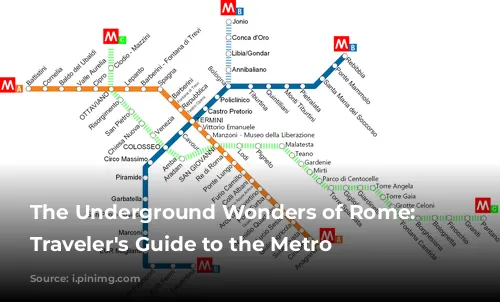Rome’s metro, lovingly nicknamed the “subway” or “underground,” might not be the largest in Europe, but it’s a vital artery for navigating the Eternal City. Since its inauguration in 1955, the metro has slowly expanded to encompass three lines covering 37.3 miles (60 km). This modest network is a testament to the city’s rich history, as excavations often uncover fascinating archaeological remains, forcing construction to slow down. This isn’t just a Roman phenomenon; Athens faces a similar challenge.
Navigating the City’s Treasures
Despite its limited size, the metro connects you to many of Rome’s must-see attractions. Let’s explore the three lines and key stops to make the most of your journey:
Line A: The Heart of the City
This popular line with 27 stations is a favorite among locals and tourists alike. It stretches from northwest to southeast, starting at Battistini and ending at Anagnina. The frequency is impressive, with trains running every 3 to 5 minutes, depending on the day.
Here are some essential stops along Line A, starting from the west:
- Cipro – Musei Vaticani: Your gateway to the Vatican Museums and the Sistine Chapel.
- Ottaviano – San Pietro: Just a short walk from St. Peter’s Square and St. Peter’s Basilica.
- Spagna: A perfect stop for exploring Piazza di Spagna and Villa Borghese.
- Barberini – Fontana di Trevi: Just a five-minute stroll from the iconic Trevi Fountain. It’s also the closest station to Piazza Navona and the Pantheon.
- Termini: Your connection point to the Roma Termini railway station. Catch the Leonardo Express here to reach Fiumicino Airport.
Line B: Connecting History and Modernity
Line B journeys from northeast to south, with two branches: one reaching Rebibbia and the other Jonio. The line boasts 22 stations with an additional four stations under construction. Weekdays see trains running every 5 minutes, while on weekends the frequency drops to 9 minutes.
Here are some highlights along Line B:
- Termini: The main transfer point between lines A and B. It’s also the arrival point of the Leonardo Express from Fiumicino Airport.
- Colosseo: Your entrance to the Colosseum and the Roman Forum.
- Piramide: This station offers a convenient link to the FR1 regional train from Fiumicino Airport.
Line C: Expanding Horizons
Line C was inaugurated in 2012, with its two branches separating at Bologna station towards Rebibbia and Jonio. This line is still under development and currently serves mostly the eastern area of Rome.
Line C was opened in 2014, extending from the city center to the east. It connects San Giovanni (Line A) to Monte Compatri-Pantano. Although less popular with tourists right now, it serves the eastern region with limited attractions. Trains operate every 12 minutes on all days of the week.
Ticket Information: Your Key to Exploration
You can purchase metro tickets at stations, newsstands, and most corner shops. For frequent travelers, consider buying multiple tickets at once or investing in a travel card.
The metro operates daily from 5:30 am to 11:30 pm, with the last train departing from each station at that time. On Fridays and Saturdays, the service is extended until 1:30 am.
For detailed information on fares, discounts, and travel cards, check out our article on tickets and travel cards in Rome.
So, hop on the metro and explore the wonders of Rome! Whether you’re tracing the footsteps of emperors or discovering hidden gems, the city’s underground network is your reliable companion.
